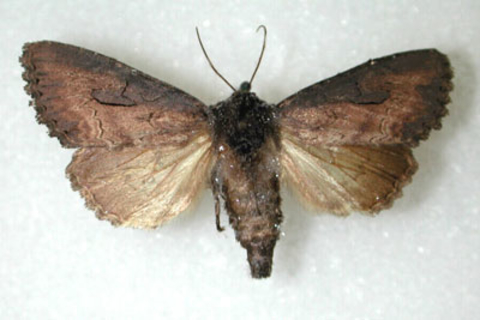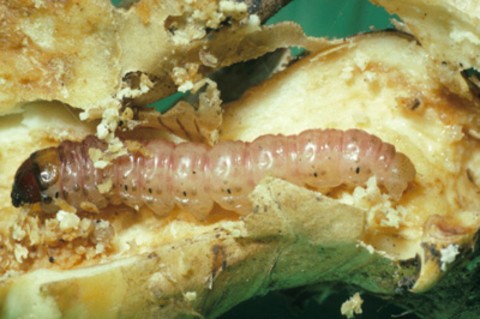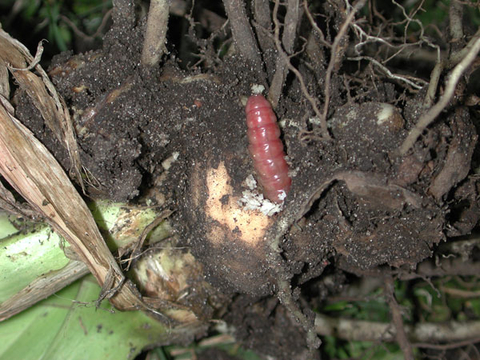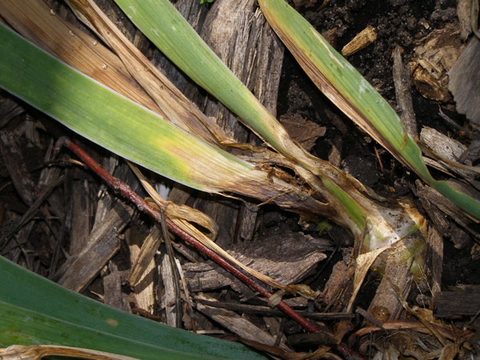Quick facts about iris borers
Iris borer caterpillars (Macronoctua onusta) are the most destructive insect pests of iris.
- The caterpillars chew holes into the leaves and tunnel all the way into the rhizome.
- The tips of iris leaves turn brown and seem to be dying, but the entire plant dies very rarely.
- Iris borers cause severe damage to iris by feeding on the rhizome.
- Management of iris borers is difficult, but damage caused by them can be reduced.
- Pesticides or natural enemies of iris borers may be used to control these insects.
How to identify iris borers
- The pinkish caterpillars are two inches long when full grown.
- Adult moths have chocolate-brown front wings and lighter yellow-brown hind wings with a wing span up to 2 inches.
- Moths are seldom seen because they fly at night.
Life cycle of iris borers
Iris borers spend the winter as eggs on old iris leaves and plant debris at the base of iris stalks.
- In early spring, they hatch into tiny caterpillars and climb up new foliage.
- The caterpillar ( 1½ to 2 inches in length) tunnels through the leaves reaching the rhizome by mid summer (July in Minnesota)
- In late July or early August, caterpillars move into the soil where they transform into pupae.
- They emerge as moths in late summer or fall.
Female moths complete the life cycle by laying eggs on old iris plants in August and September where eggs remain until next spring.
Damage caused by iris borers
They chew pinprick-sized holes and tunnel inside leaves as they continue down toward the rhizome, the food-storage unit for the plant that sends roots downward and shoots with sword-shaped leaves grow upward.
Iris borer feeding causes streaks that appear tan or water-soaked and can allow the entry of a bacterial soft rot. Rhizomes infected by soft rot are slimy, soft and foul-smelling.
Other iris diseases, like bacterial soft rot, iris scorch and fungal leaf spot, may show the same symptoms, even when iris borers are not present. All of these diseases will cause iris leaf tips to brown and iris plants to weaken, similar to symptoms caused by iris borers.
How to protect your iris plant from iris borers
Pick resistant varieties
All types of iris can be attacked by iris borer, but, Siberian iris are more tolerant to iris borer attack.
Identify the damage on time
In spring:
- Check iris during spring for signs of chewing damage and water-soaked streaks on leaves. This injury can be easily overlooked so look carefully.
- If you find damage early in the season, you can crush the insect while it is inside the leaf or remove the damaged leaf.
In summer:
- Inspecting iris in July is very important if you are having problems with iris borer.
- If an iris plant has above-ground symptoms (brown leaf tips, signs of dying leaves), dig it up and check the rhizomes.
- Discard rhizomes with iris borer caterpillars and tunnels.
In fall:
- Remove and destroy (e.g. burning or burying) old iris leaves, stems and any nearby plant debris.
- This will remove and kill eggs, and reduce the risk of iris borers next year.
- Clean up iris beds anytime after a hard frost (when female moths are no longer laying eggs).
Use of insecticides
A well-timed pesticide application can help reduce an iris borer infestation. Two options are acephate or spinosad.
- It is important to apply the pesticide when eggs are just hatching. The leaves should be about four to six inches high at this time.
- A repeat treatment 10-14 days after the first application may be necessary.
If your irises have not been affected in the past, you do not need to use a pesticide to protect them. Be watchful to prevent problems and to help detect an iris borer problem when it first begins.
CAUTION: Mention of a pesticide or use of a pesticide label is for educational purposes only. Always follow the pesticide label directions attached to the pesticide container you are using. Remember, the label is the law.
Using natural enemies
Beneficial nematodes (roundworms) are a natural option to help control some borers. They are microscopic worms that look for and kill the caterpillars by introducing a bacteria. They may not always be effective, but are generally able to reduce the number of iris borers.
Two species of roundworms (that can attack iris borers) are commercially available from natural garden supply catalogs or your local garden center:
Heterorhabditis
Steinernema
These roundworms need a moist environment to survive and move.
The easiest time to apply is during a rain shower. You can also water iris before and after applying roundworms.
Apply roundworms when iris leaves are almost fully expanded but before flowering.
Repeat the treatment approximately one week later.
Check for the expiration date on the package. The application will be most effective when used within this date.
Reviewed in 2018






